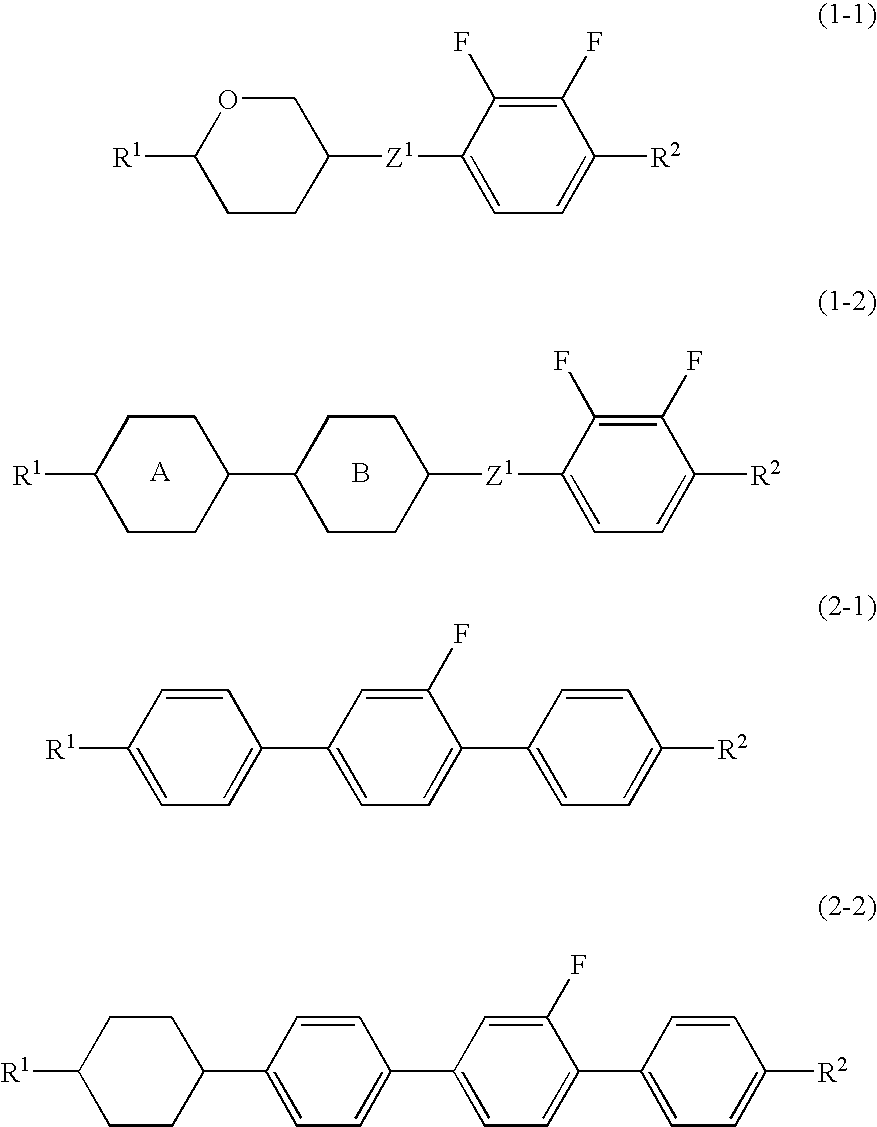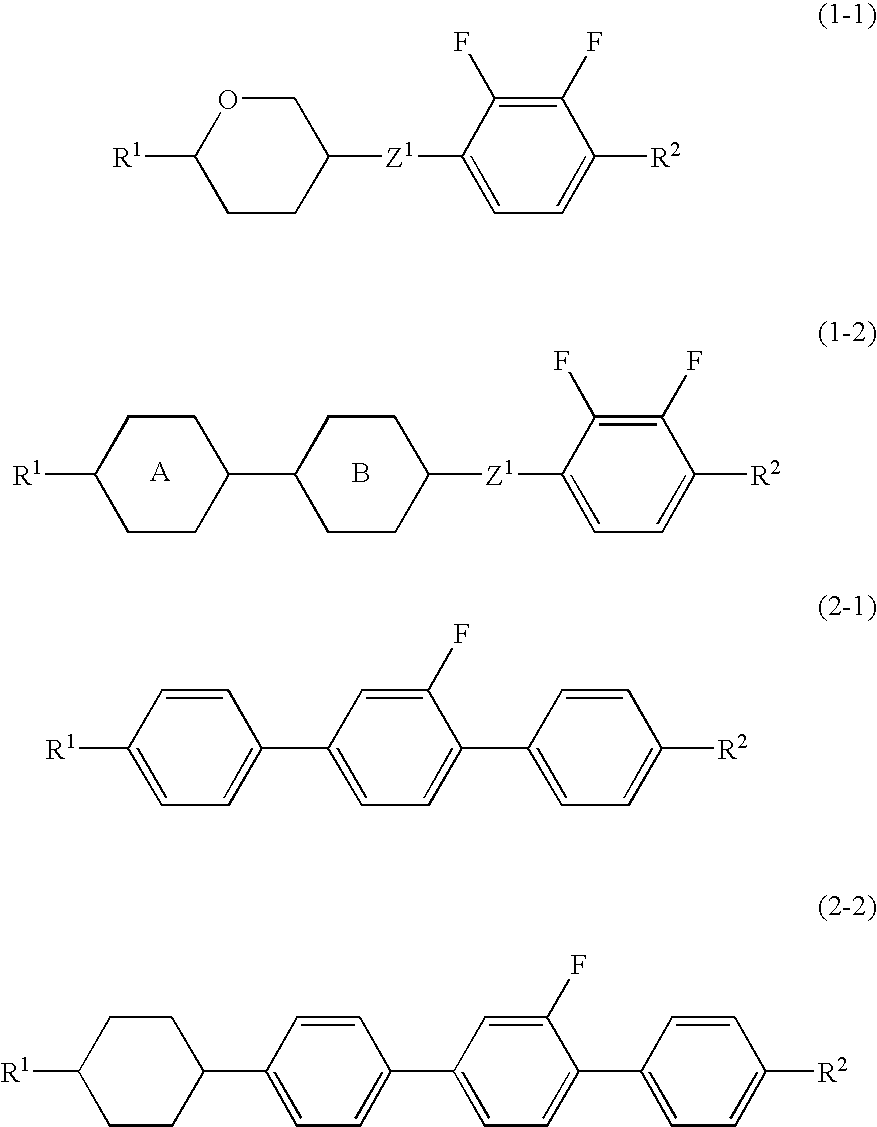Liquid crystal composition and liquid crystal display device
a liquid crystal composition and display device technology, applied in the direction of instruments, chemistry apparatus and processes, thin material processing, etc., can solve the problems of large contrast ratio of the device, small electric power consumption, and long service life of the devi
- Summary
- Abstract
- Description
- Claims
- Application Information
AI Technical Summary
Benefits of technology
Problems solved by technology
Method used
Image
Examples
example 1
[0092]The composition of Example 1 had a high maximum temperature of a nematic phase, negatively large dielectric anisotropy, and a large optical anisotropy as compared to the composition of Comparative Example 1 and 2.
3-DhHB(2F,3F)—O2(1-2-1)7%5-DhHB(2F,3F)—O2(1-2-1)7%3-HDhB(2F,3F)-1(1-2-2)8%5-HDhB(2F,3F)-1(1-2-2)8%3-HDhB(2F,3F)—O1(1-2-2)7%3-HDhB(2F,3F)—O2(1-2-2)8%5-HDhB(2F,3F)—O2(1-2-2)8%V—HDhB(2F,3F)—O2(1-2-2)7%V2-HDhB(2F,3F)—O2(1-2-2)7%1V2-HDhB(2F,3F)—O2(1-2-2)7%2-BB(3F)B-3(2-1-1)5%2-BB(3F)B-5(2-1-1)7%3-BB(3F)B-3(2-1-1)7%V2-BB(3F)B-1(2-1-1)7%NI = 118.2° C.; Tc ≦−20° C.; Δn = 0.144; Δε = −5.3; η = 47.5 mPa · s; VHR-1 = 99.1%; VHR-2 = 98.1%; VHR-3 = 97.9%.
example 2
[0093]The composition of Example 2 had a high maximum temperature of a nematic phase, negatively large dielectric anisotropy, and a large optical anisotropy as compared to the composition of Comparative Example 1 and 2.
3-DhB(2F,3F)—O2(1-1-1)10%5-DhB(2F,3F)—O2(1-1-1)10%3-Dh2B(2F,3F)—O2(1-1-2)10%5-Dh2B(2F,3F)—O2(1-1-2)10%3-Dh1OB(2F,3F)—O2(1-1-3)5%5-Dh1OB(2F,3F)—O2(1-1-3)5%3-DhHB(2F,3F)—O2(1-2-1)6%5-DhHB(2F,3F)—O2(1-2-1)6%3-HDhB(2F,3F)-1(1-2-2)5%3-HDhB(2F,3F)—O2(1-2-2)5%3-HBB(3F)B-3(2-2-1)7%3-HBB(3F)B-4(2-2-1)7%5-HBB(3F)B-2(2-2-1)7%5-HBB(3F)B-3(2-2-1)7%NI = 92.6° C.; Tc ≦−20° C.; Δn = 0.122; Δε = −5.3; η = 48.4 mPa · s.
example 3
[0094]The composition of Example 3 had a high maximum temperature of a nematic phase, negatively large dielectric anisotropy, and a large optical anisotropy as compared to the composition of Comparative Example 1 and Comparative Example 2.
3-DhB(2F,3F)—O2(1-1-1)8%5-DhB(2F,3F)—O2(1-1-1)8%1V2-DhB(2F,3F)—O2(1-1-1)8%3-Dh2B(2F,3F)—O2(1-1-2)8%5-Dh2B(2F,3F)—O2(1-1-2)8%3-DhHB(2F,3F)—O2(1-2-1)7%5-DhHB(2F,3F)—O2(1-2-1)7%3-BDhB(2F,3F)—O2(1-2-4)8%5-BDhB(2F,3F)—O2(1-2-4)8%2-BB(3F)B-3(2-1-1)5%2-BB(3F)B-5(2-1-1)5%3-BB(3F)B-3(2-1-1)5%5-HBB(3F)B-2(2-2-1)8%5-HBB(3F)B-3(2-2-1)7%NI = 95.3° C.; Tc ≦−20° C.; Δn = 0.145; Δε = −5.3; η = 46.1 mPa · s.
PUM
| Property | Measurement | Unit |
|---|---|---|
| temperature | aaaaa | aaaaa |
| temperature | aaaaa | aaaaa |
| frequency | aaaaa | aaaaa |
Abstract
Description
Claims
Application Information
 Login to View More
Login to View More - R&D
- Intellectual Property
- Life Sciences
- Materials
- Tech Scout
- Unparalleled Data Quality
- Higher Quality Content
- 60% Fewer Hallucinations
Browse by: Latest US Patents, China's latest patents, Technical Efficacy Thesaurus, Application Domain, Technology Topic, Popular Technical Reports.
© 2025 PatSnap. All rights reserved.Legal|Privacy policy|Modern Slavery Act Transparency Statement|Sitemap|About US| Contact US: help@patsnap.com



